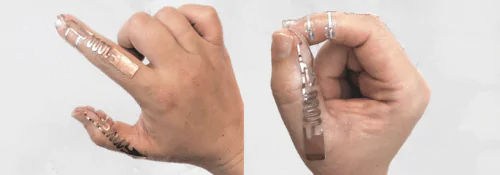Computer scientists at the University of Waterloo have created a wearable input device and suitable for many situations: it works simply by touching the fingers together in different ways.
To see it, it looks like one of those pieces of adhesive tape that are fixed on the muscles to improve performance: and in a sense Tip-Tap does just that. Tip-Tap is a kind of tactile adhesive mouse. A mouse of the future.
It's a skin sticker made from inexpensive materials, and doesn't need batteries thanks to the use of radio frequency identification (RFID) tags to detect when you touch your fingers.
The fields of application of Tip-Tap? Lot of. Mainly in the medical field, though.
Tip-Tap could be added for example to disposable surgical gloves, providing a practically invisible and non-invasive interface. It would allow surgeons to manage preoperative planning charts directly while they are in the room.
“One of the many possible applications of the device is in surgical interventions. What typically happens now with digital pre-planning surgery is that an assistant is responsible for navigating the computer and communicating with the surgeon, but this is slow and difficult”. To say it is the professor Daniel Vogel, who teaches at the David R. Cheriton School of Computer Science in Waterloo. He is one of the authors of this prototype.
An adhesive mouse for the operating room
“Currently a surgeon cannot navigate alone using a touchscreen or a mouse, because it would require constant sterilization and the current alternatives in VR they can become very tiring. The idea is that if you fit Tip-Tap into surgical gloves, surgeons could navigate the computer from where they are without getting in the way of other actions like picking up a scalpel.”
The researchers created the Tip-Tap adhesive mouse prototype as part of a new partnership with the National Research Council of Canada (NRC).
The future is a world of interfaces ever closer to our body: and to our natural way of expressing ourselves. The future is made of devices applied on our body, and also inside. The RFID mouse in this article is just one of many devices that will be developed.
They will communicate and interact with the rest of the world, they will give us extra senses, and perhaps more sense.


